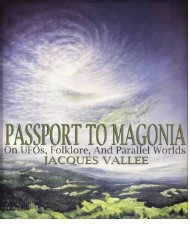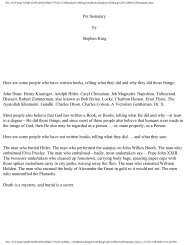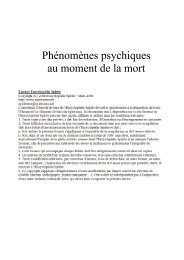extraordinary%20encounters
extraordinary%20encounters
extraordinary%20encounters
You also want an ePaper? Increase the reach of your titles
YUMPU automatically turns print PDFs into web optimized ePapers that Google loves.
On May 7, 1955, a Caracas, Venezuela,<br />
newspaper, El Universal, carried a sensational<br />
story of an incident supposed to have taken<br />
place almost exactly five years earlier. A man<br />
claimed that while driving down a rural highway<br />
in Argentina, he spotted a flying saucer<br />
that had landed on the side of the road. Curious,<br />
he stopped his car, approached the craft,<br />
and eventually boarded it. Inside, he found<br />
the bodies of three little men lying near an instrument<br />
panel. After touching one, he panicked<br />
and fled, to return the next day to see<br />
UFOs hovering over the site. Where the original<br />
craft had been there was only a pile of<br />
warm, gray ashes. Years later, a retrospective<br />
investigation by Argentine ufologists determined<br />
that the “witness” had made up the<br />
story.<br />
More intriguing was an account given in<br />
confidence to Isabel L. Davis, one of the most<br />
intelligent, hard-headed, first-generation ufologists<br />
and a fierce critic of the more outlandish<br />
saucer tales. Davis never published the<br />
account in her lifetime, but she found it intriguing,<br />
given that the informant, a medical<br />
scientist, seemed serious and credible. Even<br />
so, the scientist’s claim was a fantastic one. In<br />
the late 1950s, she told Davis, she was directed<br />
to a secure, government-run facility<br />
and ordered to examine body parts that she<br />
quickly recognized as humanlike but not<br />
human. Her superiors provided no explanations<br />
or further details, and when her work<br />
was completed, they instructed her to tell nobody.<br />
As she remarked to Davis, she would<br />
not have done so anyway, since no one would<br />
have believed her.<br />
Another tale—this one circulated by saucer<br />
personality and publisher Gray Barker—concerned<br />
Nicholas von Poppen, an Estonian<br />
refugee who had fled his native country when<br />
Soviet troops overran it and slaughtered his<br />
family. That much of the story seems true (the<br />
real Von Poppen died in Los Angeles in<br />
1976). Beyond that, however, Barker and<br />
truth parted company. He took an unpublished<br />
science-fiction manuscript written by a<br />
subscriber to his magazine The Saucerian and<br />
Dead extraterrestrials 83<br />
transformed it into a “true” story. In the original,<br />
the writer/subscriber had taken a colorful,<br />
real acquaintance, Von Poppen, and placed<br />
him inside a fantasy in which Von Poppen<br />
took photographs in New Mexico of a crashed<br />
UFO and its occupants. Barker took this story<br />
and embellished it further, then marketed it as<br />
an account of an authentic incident—not the<br />
only hoax Barker would perpetrate on his impressionable<br />
readers.<br />
In the 1970s, ufologist Leonard H. Stringfield,<br />
in the face of criticism and skepticism<br />
from some colleagues, began collecting<br />
crash/retrieval claims and rumors and publishing<br />
them in a series of monographs. None<br />
amounted to much as evidence, though some<br />
were undeniably interesting, such as the testimony<br />
of a Presbyterian pastor. This man—<br />
Stringfield protected the names of his informants—alleged<br />
that when he was a boy, he and<br />
his father (also a clergyman) visited the Museum<br />
of Science and Industry in Chicago.<br />
During one visit, they got lost. In their search<br />
for an exit, they accidentally entered a room<br />
where a number of humanoid beings lay preserved<br />
under a glass-covered case. Before they<br />
could fully grasp what they were seeing, they<br />
were discovered. The father was pressured to<br />
sign papers swearing him to silence.<br />
In another alleged instance, said to have<br />
taken place at a New Jersey air force base in<br />
January 1978, a sergeant—who insisted on<br />
anonymity—told Stringfield that in the early<br />
morning hours a military policeman had shot<br />
and killed a humanoid being that he had encountered<br />
while chasing a UFO in his car.<br />
The body was then shipped off to Wright-Patterson<br />
Air Force Base. The sergeant eventually<br />
provided an official-looking “incident report,”<br />
with the names of witnesses and investigators<br />
inked out. Stringfield’s informant talked and<br />
acted in a manner that he and fellow ufologist<br />
Richard Hall, who interviewed the man in<br />
person on two occasions, deemed sincere, but,<br />
despite a serious effort, they uncovered nothing<br />
that conclusively verified the claim.<br />
Perhaps the most interesting of Stringfield’s<br />
informants were several “medical people” who





